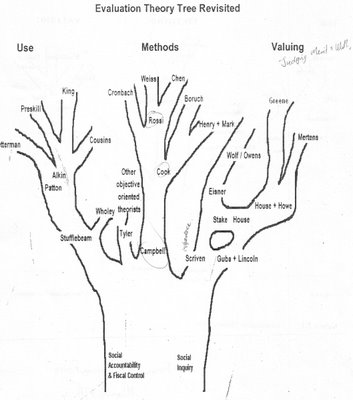I find the readings on the pelican listserve (Pelican Initiative: Platform for Evidence-based Learning & Communications for Social Change) always interesting. Today the message below was posted.
I find the description of Social Auditing quite interesting. At first I thought it might be similar to Social Accounting - the move of private companies to also account on the triple bottom line of Environmental, Social and Economical impacts (costs and benefits) in order to promote corporate responsibility. We've actually done a couple of sustainability reports using this framework. The focus, however is more on accountability than it is on changing things for improvement. Hope it is not the same for this kind of local government monitoring.
I have also previously posted something on the MSC techniques described here. I think it is quite useful if there are no clearly defined objectives to start off with, or if the social reality is very complex and requires more of a systems look at the effects. Any case. You decide for yourself!
PS. the AEA conference is on in Baltimore this week, and although I am not able to attend, my business partner is. It sounds like it is interesting and stimulating as always!
Ciao
B
**********************************************
Last month, a number of useful documents and experiences were shared by Gilles Mersadier, who is the coordinator of the FIDAfrique network (http://www.fidafrique.net/article413.html). Among the material that he shared, he referred to a methodology for capitalisation (the process of sharing experiences among and across organisations) that is being used in the context of 25 West-African rural development projects. To date, 20 of these projects have published different types of documents that are disseminated throughout the FIDAfrique network. The production of these documents, which are available on the network's website, are supported by a methodological guide on the capitalisation process (in French and
English):
http://www.fidafrique.net/article467.html?var_recherche=capitalization
In the past few weeks, different contributions have been sent in the context of the discussion around local monitoring of public service delivery. One of the questions which we posed in the beginning of this discussion focused on the types of approaches that are being used for local monitoring purposes. In this message, I would like to briefly describe two of such approaches:
1: Social Auditing
2: Most Significant Change
**** 1: Social Auditing
The Social Auditing method has been developed and used for participatory monitoring of public service delivery by the organisation CIET (for more info on the organisation, which started in 1985 in Mexico and developed into an international network, please visit http://www.ciet.org/en/aboutciet/ ).
The method's primary aim is to 'increase the informed interaction between communities and public services'. The impact, coverage and costs of public services are examined through a combination of quantitative (survey) and qualitative (key informant and focus groups) evidence. The civil society plays a central role in interpreting this evidence, and through this process contributes to the creation of local solutions. The use of both 'hard' and 'soft' evidence helps to provide a strong and accurate underpinning to the locally defined ideas and solutions, and as such strengthens the legitimacy of the solutions that are developed.
A report that was published in 2005 on the use of the method for assessing 'governance and delivery of public services' in Pakistan lists the following seven stages of a Social Audit cycle:
(1) Clarify the strategic focus;
(2) Design sample and instruments, pilot testing;
(3) Collect information from households on use and perception of public services;
(4) Link this with information from the public services;
(5) analyse the findings in a way that points to action;
(6) Take findings back to the communities for their views about how the improve the situation;
(7) Bring evidence and community voice into discussions between service providers, planners and community representatives to plan and implement changes.
The CIET website features an extensive library section where the reports of previous social audits can be accessed, together with other experiences relating to the network's central focus on the 'socialisation of
evidence':
http://www.ciet.org/en/browse/librarydocs/
**** 2: Most Significant Change
Central in the Most Significant Change (MSC) technique is - as the name suggests - the collection of significant change stories that emerge from the field level. Following the collection of these stories, those stories which are considered most significant are selected by panels of designated stakeholders or staff. The collection, discussion and further selection of the stories revolves around 'domains': the areas that the stakeholders collectively decide on as the focus of the monitoring. Provided that it is clear who is involved at selecting the stories at the different levels, the use of the domains makes for a transparent monitoring process. Given these characteristics, and the fact that it is relatively easy to learn how to use it, the technique can be useful in the context of local monitoring of public service delivery.
While an English guide about the technique has been available since 2005
(see: http://www.mande.co.uk/docs/MSCGuide.htm ), efforts have also been made to translate the guide into different international and local languages, including Spanish, French, Russian, Tamil and Indonesian. Rick Davies has set up a specific Web Log to make available these translations, and to allow users to share suggestions to further improve the quality of the translations. You can access this website here:
http://mscguide-translations.blogspot.com/
Our current discussion on the topic of local monitoring of public service delivery is moving towards an end, so it would be great if some of you could still share some experiences and ideas on this topic in case you did not yet have the time to do so. We will aim to send around a summary of the key points that have been contributed sometime next week.
Best wishes,
Niels


